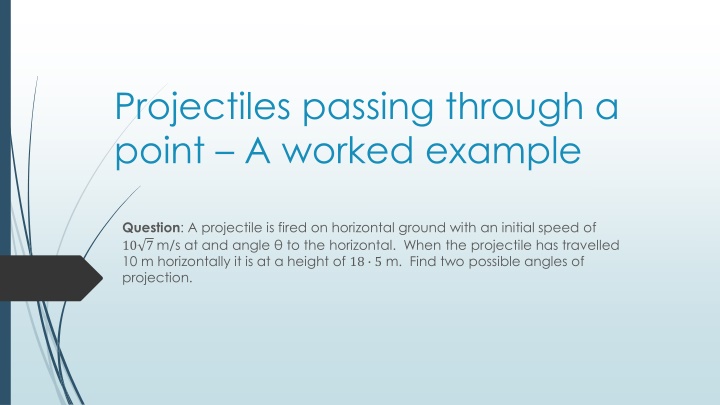
Projectile Motion Example: Finding Angles of Projection
Learn how to find two possible angles for the projection of a projectile based on horizontal and vertical distances traveled, with step-by-step calculations and trigonometric identities.
Uploaded on | 2 Views
Download Presentation

Please find below an Image/Link to download the presentation.
The content on the website is provided AS IS for your information and personal use only. It may not be sold, licensed, or shared on other websites without obtaining consent from the author. If you encounter any issues during the download, it is possible that the publisher has removed the file from their server.
You are allowed to download the files provided on this website for personal or commercial use, subject to the condition that they are used lawfully. All files are the property of their respective owners.
The content on the website is provided AS IS for your information and personal use only. It may not be sold, licensed, or shared on other websites without obtaining consent from the author.
E N D
Presentation Transcript
Projectiles passing through a point A worked example Question: A projectile is fired on horizontal ground with an initial speed of 10 7 m/s at and angle to the horizontal. When the projectile has travelled 10 m horizontally it is at a height of 18 5 m. Find two possible angles of projection.
Some background thoughts to this question: It can be helpful to consider the projectile as passing through a specific point ? ?,? ? during its motion. In this example the horizontal distance is 10 and the vertical distance is 18 5. As a co- ordinate point, this is represented by 10,18 5 . When solving these questions, we can: a) establish an expression for ? from ? ?. b) fill this value of ? into the expression for ? ?, and solve the resulting quadratic equation.
Resolving the initial speed of 10 7 into a vector we get: ? = 10 7???? ? + 10 7???? ? Taking ? ?= 10 and noting there is no horizontal acceleration so the formula ? = ?? +1 2??2simplifies to ? = ?? we get: 10 = 10 7cos?? This allows us to find an expression for time: ? = 10 10 7 cos ? As we know the vertical displacement is 18 5, we should fill this into our expression for ? ?, noting that the acceleration in the formula ? = ?? +1 given by gravity, represented by ?. 10 7cos? ? At this stage, we need to be aware of two trigonometric identities: 2??2is 10 100 18 5 = 10 7sin? 2 100 7 ???2? i. ???? ????= ???? 1 ii. ???2?= (1 + ???2?) Using these, and simplifying some of the numbers, the above equation simplifies to: 7 10(1 + ???2?) now apply a common denominator of 10: 18 5 = 10????
185 = 100???? 7 7???2? 7???2? 100???? + 192 = 0 7???? 16 ???? 12 = 0 7???? 16 = 0 ???? 12 = 0 7???? = 16 ???? = 12 ???? =16 ???? = 12 7 16 7 ? = ??? 1 ? = ??? 1(12)
Some extended thoughts. This type of question can appear in different guises if a projectile just clears a wall of a certain height a certain distance from the point of projection, we can assume the distance of the wall from the point of projection and its height to be a co-ordinate point ? ?,? ? and proceed as outlined in the worked example. Whilst ???? frequently in Applied Maths and regular Maths that you will become quite familiar with it. ????= ???? is in the Formulae and Tables Book (Pg. 13), it is used 1 However, book so you should learn it specifically for these questions. 1+???2?= ???2? is not readily available in the Formulae and Tables
